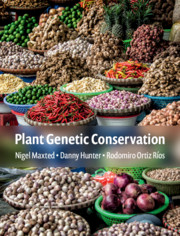Book contents
- Frontmatter
- Frontispiece
- Contents
- Foreword
- Preface
- Acknowledgements
- Part I Introduction
- Part II Scientific Background
- Part III Conservation Practice
- 6 Planning Plant Conservation
- 7 Conservation Strategies and Techniques
- 8 In Situ Conservation
- 9 On-Farm Conservation
- 10 Community-Based Conservation
- 11 Germplasm Collecting
- 12 Seed Gene Bank Conservation
- 13 Whole Plant, Plantlet and DNA Conservation
- Part IV Plant Exploitation
- Acronyms and Abbreviations
- Glossary
- References
- Index
- Plate section
6 - Planning Plant Conservation
from Part III - Conservation Practice
Published online by Cambridge University Press: 05 September 2020
- Frontmatter
- Frontispiece
- Contents
- Foreword
- Preface
- Acknowledgements
- Part I Introduction
- Part II Scientific Background
- Part III Conservation Practice
- 6 Planning Plant Conservation
- 7 Conservation Strategies and Techniques
- 8 In Situ Conservation
- 9 On-Farm Conservation
- 10 Community-Based Conservation
- 11 Germplasm Collecting
- 12 Seed Gene Bank Conservation
- 13 Whole Plant, Plantlet and DNA Conservation
- Part IV Plant Exploitation
- Acronyms and Abbreviations
- Glossary
- References
- Index
- Plate section
Summary
Conservation planning involves selecting target taxa, establishing the geographic and taxonomic breadth of the conservation actions and producing some form of strategy or action plan for implementation. The selection of which taxon or taxa to conserve should be based on a series of measurable criteria such as the threat of genetic erosion / extinction, value of the taxon to humankind or the ecosystem, or the potential ease of use of the taxon or taxa. Once the target taxon is chosen, its geographic distribution, habitat preferences, phenology, and taxonomy are established to identify gaps in existing conservation actions to formulate an effective conservation strategy. Gap analysis is used to analyse the literature, passport data on gene bank accessions, label information on herbarium specimens for each taxon, as well as consulting taxonomic experts, and databases and concludes with strategic action to enhance conservation. Increasingly these strategic actions are tested in terms of their mitigation of climate change for the target taxon / taxa and formulated into a national strategy and action plan that gives background to their selection and clearly establishes the required conservation actions needed. The success of these actions is then measured against biodiversity indicators, so progress can be reviewed.
Keywords
- Type
- Chapter
- Information
- Plant Genetic Conservation , pp. 135 - 185Publisher: Cambridge University PressPrint publication year: 2020

